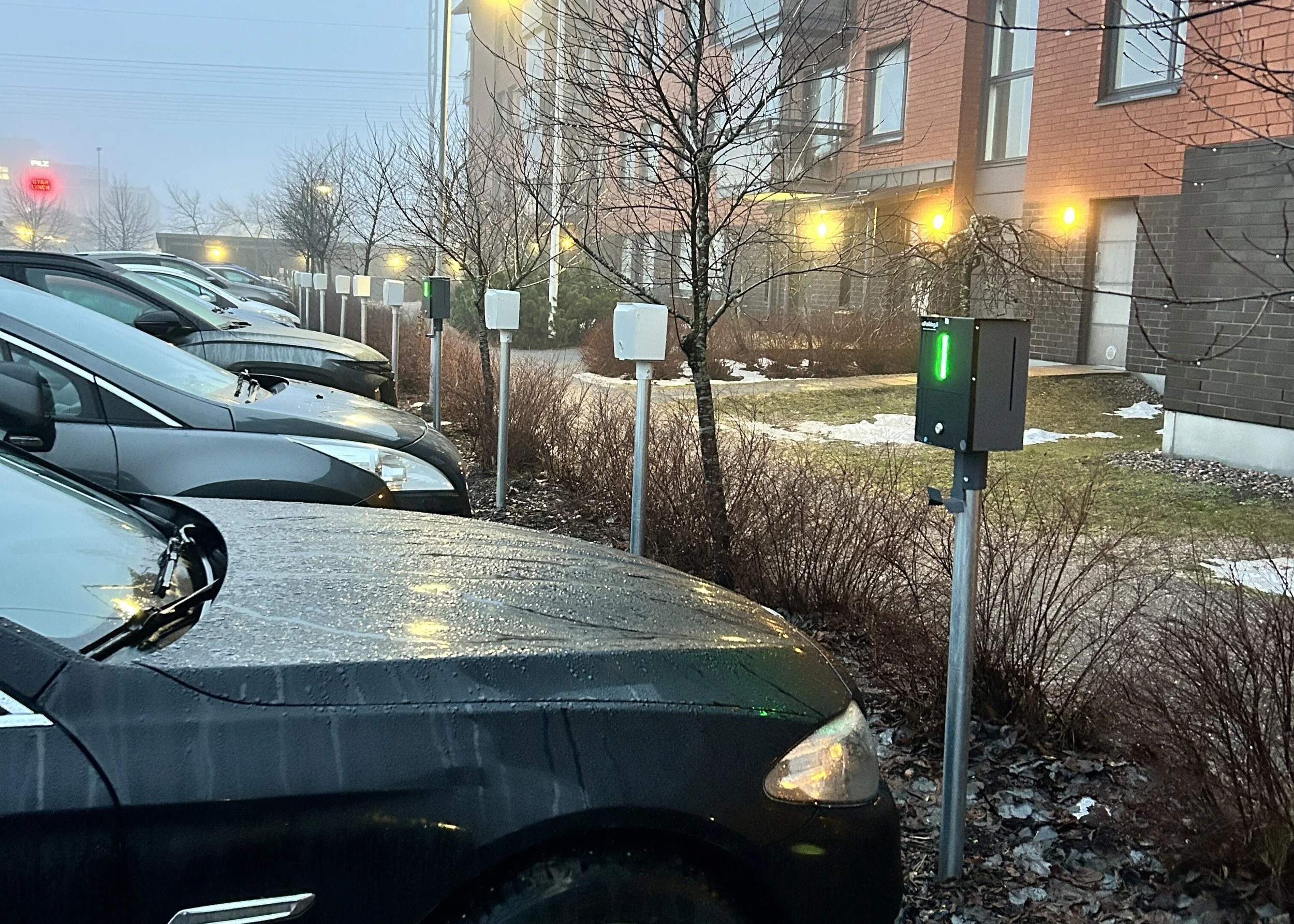As Oy Vantaa Varsta: Fluent Finnish electric cars charging to the housing company
The process of purchasing charging equipment for the housing company Vantaa Varsta started in spring 2022, when the housing company's board began investigating various possibilities for implementing electric car charging infrastructure.
The first goal was to understand what kind of solutions were available and what they would cost. Miikka Nordström, , says that the initial cooperation with a candidate developer took an unexpectedly long time. "For some reason, the investigation took an incredibly long time. In the end, we decided to look for a new operator to get the project off to a good start," he says.
Nordström started as Chairman of the Board at the same time as the purchase of charging devices began to be promoted in earnest. The issue was particularly important to him, as he was a plug-in hybrid driver himself at the time. He has since switched to a fully electric car: "I had to go without a home charger for a long time. Now my life as an electric car driver is much easier now that the devices are finally in place!"
In the end, Vantaa Varsta chose Wallen 64T as the charging devices, eParking as the application package, and Watter as the electrical contractor. The commissioning took place in August 2024, when the first charging operations were carried out. The entire process took about two and a half years in total.
At Varsta in Vantaa, the most important criteria for selecting charging devices were price, implementation model and domesticity.
Domestic and reliable versatility
The number of parking spaces in the housing company had a significant impact on the implementation of the project. "We have a total of 67 parking spaces, so there was a lot of cabling and excavation work. The project involved building a completely new infrastructure. The study showed that it was not worth using the old cabling, because it would not produce enough power," Nordström recalls the initial stages of the process. The housing company ended up with a solution in which a completely new main electrical switchboard and connection were built. This ensures, in accordance with the housing company's wishes, that even if the charging connection were to fail for some reason, it would not jeopardize the operation of the building's elevators or ventilation.
The most important criteria in choosing the charging devices were price, implementation model and domesticity. "Of course, price played a big role. But it was also of great importance that we were recommended a solution where each space gets its own post. It makes changing the device much easier than in the traditional model where one charger is shared between two users," Nordström says. In addition, the solution ensures that the decision of the partner in the neighboring space does not affect the charging possibilities of the other partner: if one of the parking spaces does not want charging and the other does, then this arrangement does not create a problem. The domesticity of the devices and the device manufacturer also played a role in the decision-making. The Walle charging devices selected for the housing company are manufactured at the own factory of the domestic manufacturer Trafomic Oy in Raisio. They have a durable metal shell and are specially designed to withstand the changing weather conditions of the Nordic region.
The Wallen 64T chargers have both a Type 2 connector and a SUKO socket. "We wanted the devices to also be able to be used to heat the car or, for example, to use a vacuum cleaner or other electrical devices if necessary. A device that only allows charging would not be as versatile, which would make it difficult to use." The housing company did not give much thought to modularity and the life cycle of the devices. However, Nordström notes that it is always an advantage not to have to replace everything if something breaks or needs to be updated.
Future-proof solutions
The number of electric cars in Vantaa Varsta is still relatively moderate: the housing company currently has three fully electric cars and two plug-in hybrids. The availability of charging facilities has therefore not yet caused a major rush to change cars. “However, changing a car is a big investment, so the change will not happen overnight,” Nordström reflects.
The housing company has introduced both charging devices purchased by the housing company and those purchased by the shareholders themselves. There are currently five housing company chargers and six shared chargers installed, i.e. a total of 11 devices. One of the charging devices purchased by the housing company is in use, and the rest can be used as needed. According to Nordström, currently four chargers are actively used for charging cars and two for heating. Five devices are still waiting for their users. "We did not set out to make a huge initial investment, but with this solution, additions can be made as needed," he sums up.
Ease appreciated by users in their own backyard
User experiences have been positive. The first comment Nordström received was related to the charging price decided by the housing company, which is only slightly cheaper than the average public charging price. “The idea is not that home charging is significantly cheaper, but that it is easy: you come home, plug in the charging cable, and the car charges exactly when you want,” he describes. The initial commenter has since proven to be the housing company's most active home charger.
The Wallen 64T chargers have a power output of 11 kW, and there have been very few technical challenges. The 4G modem, which had been stuck a couple of times, has worked fine after a software update. According to Nordström, eParking's customer service has also worked very well. "Here in Pakkala, there are approximately 50 public charging stations within a kilometer radius, so if home charging ever happens to not work, other options are readily available."
The invoicing service and the use of the app have worked smoothly at Vantaa Varsta. "Payments can be easily accepted in the system, and that's it," he describes. However, Nordström highlights one development suggestion: "I use a company car myself, but the system does not allow for the separation of charging reports for different cars. If I also charged another car in our family, it would be good if the charging events for different cars could be separated. This way, the company's charging would not get mixed up with personal ones. This would be a good development target for eParking."
Overall, the project has progressed successfully, although the initial investigation and decision-making took longer than expected. The housing company now has a functioning charging infrastructure that enables a scalable system according to needs and reliably serves both current and future residents of the housing company who drive electric cars.
Miikka Nordström, chairman of As Oy Vantaa Varsta housing company, was interviewed for the reference.

